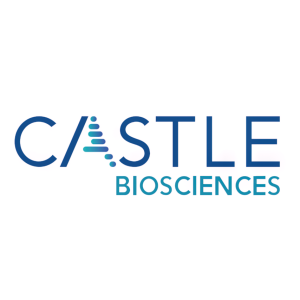Real-World Study Confirms Long-Term Performance of DecisionDx®-UM for Metastatic Risk Stratification in Uveal Melanoma and Utility of PRAME Biomarker for Refining Risk When Considered with the DecisionDx-UM Class Result
Rhea-AI Summary
Castle Biosciences (NASDAQ: CSTL) presented new data validating their DecisionDx-UM test and PRAME biomarker for uveal melanoma (UM) at the ARVO 2025 Annual Meeting. The study analyzed a real-world cohort of 1,297 patients with UM, validating findings from the COOG2.1 study.
The research confirms that combining PRAME gene expression information with DecisionDx-UM test results can better predict metastatic risk in UM patients. The study utilized data from the National Cancer Institute's SEER Program, demonstrating that co-reporting DecisionDx-UM class and PRAME status provides enhanced insights into metastasis likelihood, enabling more personalized treatment strategies for this rare but aggressive eye cancer.
Positive
- Large-scale validation with 1,297 patients confirms the effectiveness of DecisionDx-UM test
- Enhanced risk prediction capability through PRAME biomarker integration
- Collaboration with NCI SEER Program provides robust real-world data validation
Negative
- None.
Insights
Castle's real-world study validates DecisionDx-UM test performance and confirms PRAME biomarker utility for refined uveal melanoma risk stratification.
This real-world validation study represents a significant advancement for Castle Biosciences' diagnostic capabilities in uveal melanoma (UM) management. The study examined 1,297 patients with this rare but aggressive eye cancer, providing robust evidence supporting both the long-term performance of DecisionDx-UM and the clinical value of adding PRAME (Preferentially Expressed Antigen in Melanoma) biomarker testing.
The collaboration with the NCI's SEER Program is particularly valuable as it enabled linkage of real-world patient outcomes with their diagnostic test results, creating a population-based validation cohort. This type of evidence is precisely what clinicians and payers look for when evaluating diagnostic technologies.
What makes this development clinically meaningful is how the combination of DecisionDx-UM class results with PRAME status creates a more granular risk stratification model. By subdividing Class 1 and Class 2 tumors based on PRAME positive versus negative status, oncologists can develop more personalized surveillance and treatment plans.
For context, uveal melanoma has historically been challenging to risk-stratify effectively. While relatively rare with approximately 2,500 new cases annually in the US, it has a high metastatic rate (around 50%), and once metastasized, survival outcomes are poor. More precise risk stratification allows for appropriate resource allocation – intensive surveillance and potentially earlier intervention for high-risk patients, while avoiding unnecessary procedures for those at lower risk.
This validation essentially confirms the findings from the prospective COOG2.1 study, providing multiple lines of evidence supporting Castle's approach. The real-world confirmation suggests that the test's performance in controlled research settings translates to actual clinical practice, which is essential for widespread adoption and utilization.
FRIENDSWOOD, Texas, May 09, 2025 (GLOBE NEWSWIRE) -- Castle Biosciences, Inc. (Nasdaq: CSTL), a company improving health through innovative tests that guide patient care, today announced new data from the first independent validation of the recently published Collaborative Ocular Oncology Group Study No. 2 (COOG2.1) by Harbour et al.1 The data, from a real-world cohort of 1,297 patients with uveal melanoma (UM), was presented at the Association for Research in Vision and Ophthalmology (ARVO) 2025 Annual Meeting in Salt Lake City. The findings provide further support for adding Preferentially Expressed Antigen in Melanoma (PRAME) gene expression information to the DecisionDx-UM test result to further refine metastatic risk prediction for patients with UM, which is a rare but aggressive eye cancer.
"This real-world validation of the landmark COOG2.1 study both confirms the long-term performance of the DecisionDx-UM test and affirms the clinical value of PRAME as an adjunct biomarker that may further refine a patient’s metastatic risk when combined with the DecisionDx-UM class result,” said Rebecca Critchley-Thorne, Ph.D., vice-president, research and development, of Castle Biosciences. “This enhanced approach to risk stratification is designed to equip clinicians with more precise information to help guide surveillance strategies and enable more personalized treatment planning with the goal of helping to improve outcomes for patients with UM.”
Details regarding Castle’s presentation at ARVO are included below. The abstract may be viewed using the ARVO 2025 mobile meeting planner.
- Presentation Number 981: PRAME status as a risk modifier of 15-gene expression profile class: Evidence from a real-world cohort of 1297 uveal melanoma patients
- Presentation Type: Poster Session
- Session Number: 154
- Session Title: Uveal Melanoma
- Summary: An ongoing collaboration with the National Cancer Institute’s Surveillance, Epidemiology and End Results (NCI SEER) Program enabled linkage of UM patient records with such patients’ DecisionDx-UM and PRAME test results. In a large, real-world, population-based cohort of patients with UM, this study aimed to validate the findings from the prospective COOG2.1 study, which found that adding the reported expression of the PRAME gene to the DecisionDx-UM class result can further refine risk by subdividing Class 1 and Class 2 tumors based on PRAME positive (+) versus negative (-) status. Consistent with the COOG2.1 study, the findings shared at ARVO demonstrate that co-reporting of DecisionDx-UM class and PRAME status provides additional insights into a patient’s likelihood of metastasis to better inform treatment pathway decisions.
About DecisionDx-UM
DecisionDx-UM is Castle Biosciences’ 15-gene expression profile (GEP) test that uses an individual patient’s tumor biology to predict individual risk of metastasis in patients with uveal melanoma (UM). DecisionDx-UM is the standard of care in the management of newly diagnosed UM in the majority of ocular oncology practices in the United States. Since 2009, the American Joint Committee on Cancer (AJCC; v7 and v8) Staging Manual for UM has specifically identified the GEP test as a prognostic factor that is recommended for collection as a part of clinical care. Further, the National Comprehensive Cancer Network (NCCN) guidelines for UM include the DecisionDx-UM test result as a prognostic method for determining risk of metastasis and recommended differential surveillance regimens based on a Class 1A, 1B and 2 result. DecisionDx-UM is currently the only prognostic test for UM that has been validated in prospective, multi-center studies, and it has been shown to be a superior predictor of metastasis compared to other prognostic factors, such as chromosome 3 status, mutational status, AJCC stage and cell type. It is estimated that nearly 8 in 10 patients diagnosed with UM in the United States receive the DecisionDx-UM test as part of their diagnostic workup. Learn more at www.CastleBiosciences.com.
About Castle Biosciences
Castle Biosciences (Nasdaq: CSTL) is a leading diagnostics company improving health through innovative tests that guide patient care. The Company aims to transform disease management by keeping people first: patients, clinicians, employees and investors.
Castle’s current portfolio consists of tests for skin cancers, Barrett’s esophagus and uveal melanoma. Additionally, the Company has active research and development programs for tests in other diseases with high clinical need, including its test in development to help guide systemic therapy selection for patients with moderate-to-severe atopic dermatitis seeking biologic treatment. To learn more, please visit www.CastleBiosciences.com and connect with us on LinkedIn, Facebook, X and Instagram.
DecisionDx-Melanoma, DecisionDx-CMSeq, i31-SLNB, i31-ROR, DecisionDx-SCC, MyPath Melanoma, TissueCypher, DecisionDx-UM, DecisionDx-PRAME and DecisionDx-UMSeq are trademarks of Castle Biosciences, Inc.
Forward-Looking Statements
This press release contains forward-looking statements within the meaning of Section 27A of the Securities Act of 1933, as amended, and Section 21E of the Securities Exchange Act of 1934, as amended, which are subject to the “safe harbor” created by those sections. These forward-looking statements include, but are not limited to, statements concerning: the ability of the DecisionDx-UM test to guide more informed, risk-aligned management decisions through the precise risk-stratification of patients with UM; the potential increased risk stratification from including PRAME gene expression information to a patient’s DecisionDx-UM test result; and DecisionDx-UM’s value in identifying UM patients who may benefit from enhanced surveillance and management strategies to improve outcomes. The words “believe,” “can” and similar expressions are intended to identify forward-looking statements, although not all forward-looking statements contain these identifying words. We may not actually achieve the plans, intentions or expectations disclosed in our forward-looking statements, and you should not place undue reliance on our forward-looking statements. Actual results or events could differ materially from the plans, intentions and expectations disclosed in the forward-looking statements that we make. These forward-looking statements involve risks and uncertainties that could cause our actual results to differ materially from those in the forward-looking statements, including, without limitation: subsequent study or trial results and findings may contradict earlier study or trial results and findings or may not support the results obtained in these studies, including with respect to the discussion of our tests in this press release; actual application of our tests may not provide the aforementioned benefits to patients; and the risks set forth under the heading “Risk Factors” in our Annual Report on Form 10-K for the year ended December 31, 2024 and our Quarterly Report on Form 10-Q for the quarter ended March 31, 2025, each filed with the SEC, and in our other filings with the SEC. The forward-looking statements are applicable only as of the date on which they are made, and we do not assume any obligation to update any forward-looking statements, except as may be required by law.
- Harbour JW, Correa ZM, Schefler AC, et al. 15-Gene Expression Profile and PRAME as Integrated Prognostic Test for Uveal Melanoma: First Report of Collaborative Ocular Oncology Group Study No. 2 (COOG2.1). J Clin Oncol. 2024;42(28):3319-3329. doi:10.1200/JCO.24.00447
Investor Contact:
Camilla Zuckero
czuckero@castlebiosciences.com
Media Contact:
Allison Marshall
amarshall@castlebiosciences.com








